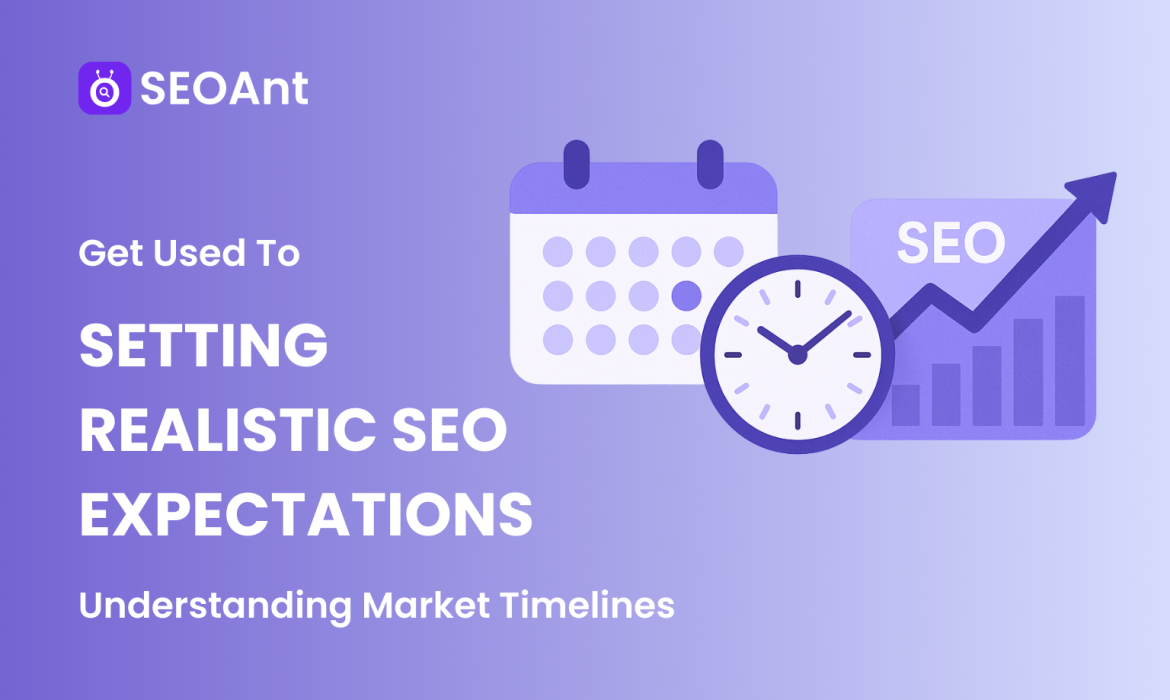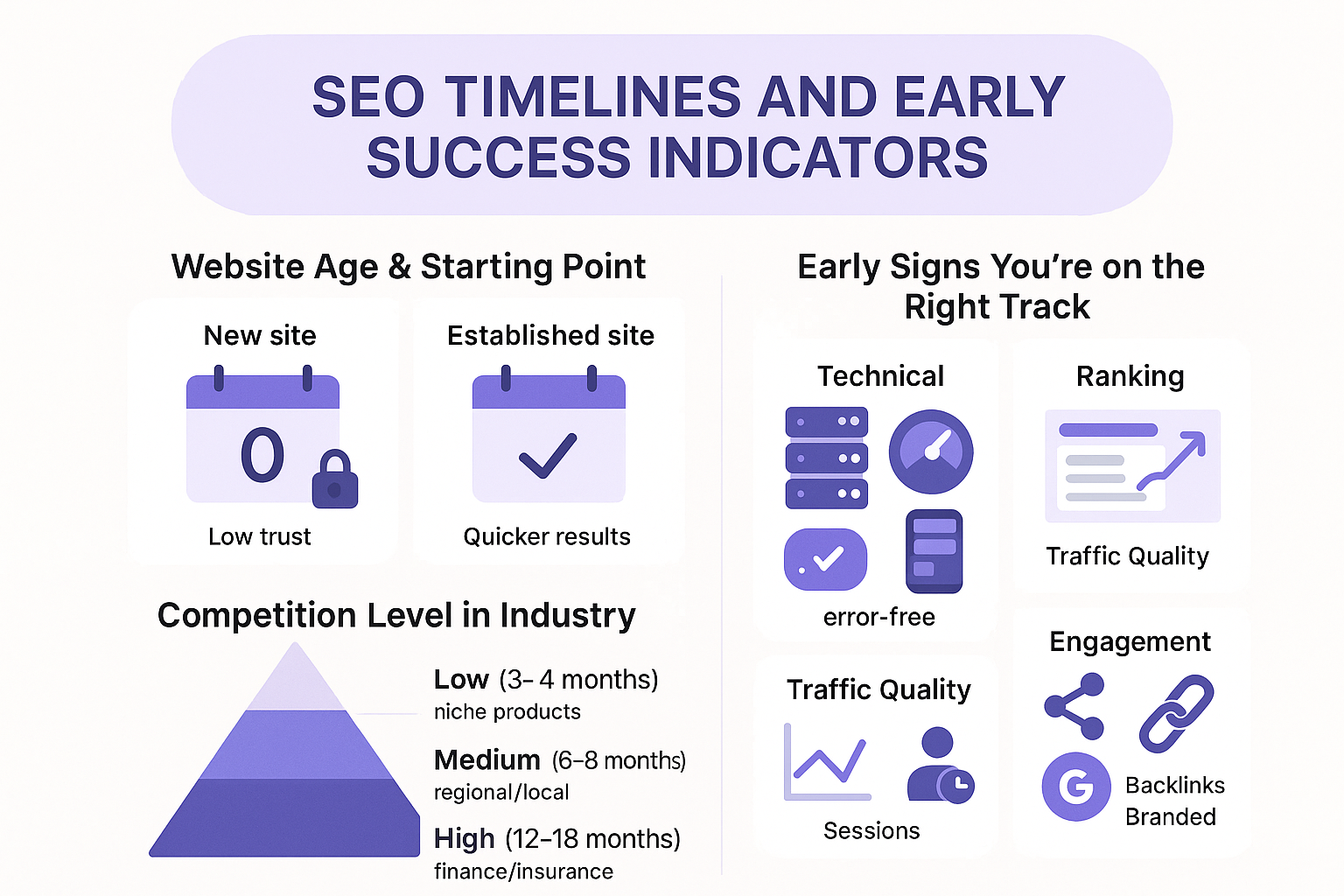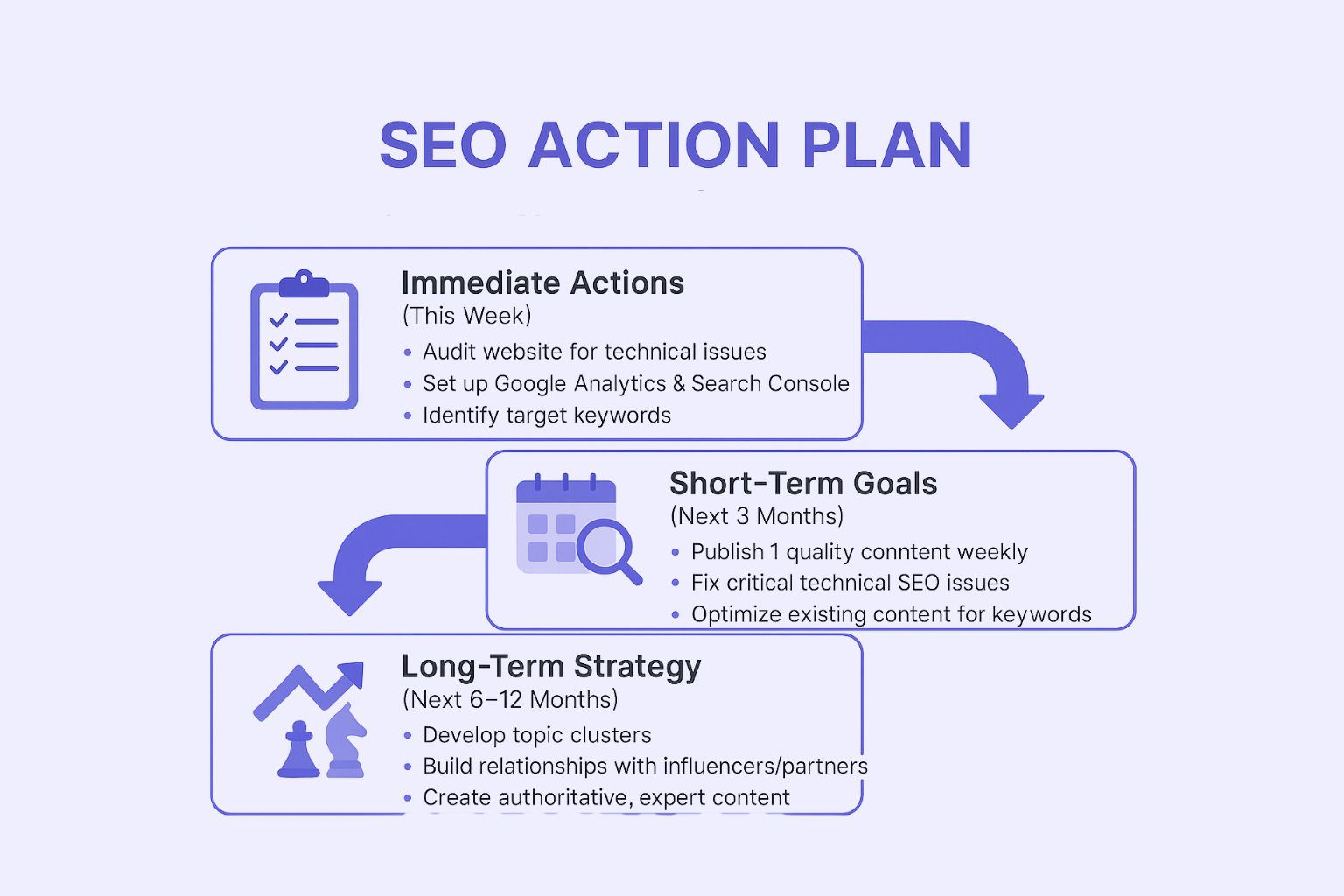
If you’ve ever asked yourself “how long does SEO take” or thought “when will I finally see results from my search engine optimization activities?”, you are in the same boat as hundreds of other business owners, especially if you’re new to digital and online marketing.
You may be surprised to learn the truth about what you can expect regarding the timeline of these results, and it is likely different than what you have been led to believe by SEO agencies who have a “one shoe fits all approach” to getting quick results. In this extensive guide, we will walk you through realistic SEO timelines, help you understand what will affect your results, and most importantly demonstrate to you how to set proper expectations around SEO results and keep you motivated throughout the whole process.
Table of Contents
Why SEO Takes Time: Understanding the Foundation
Before we look at exact timelines, it’s important to know why SEO will not happen overnight. In contrast to paid ads, where traffic is produced immediately, optimization is primarily about building trust and authority, neither of which will happen quickly.
Everyday, search engines like Google process over 8.5 billion searches, and their algorithms have come a long way in differentiating quick fixes from real value. Essentially, when someone takes action on an SEO recommendation, they are asking Google to trust the recommended website enough to suggest it to their searchers. This is something that will take time.
Consider what it takes to build reputation in your local community. Would you expect to become the most trusted local business within a month of operating? Search engines are no different; they need to see consistent, valuable contributions before they feel comfortable recommending the website to searchers.
The Realistic SEO Timeline: What to Expect Month by Month
SEO is a long-term approach rather than an instantaneous solution. SEO develops in stages, each stage relies on the performance of the previous stage. In the table below, you will find what to focus on, and what reasonable expectations you might have at various stages of the SEO process.
| Phase | Focus Areas | Realistic Expectations / Indicators |
| Months 1–3: Foundation Building Phase | – Comprehensive keyword research – Fixing technical SEO (site speed, mobile optimization, crawl errors) – Creating high-quality, optimized content – Setting up analytics and tracking systems – Building initial site structure & navigation | – Minimal ranking improvements for competitive keywords – Some ranking gains for long-tail keywords – Increased crawling by search engines – Baseline establishment in Google Search Console |
| Months 4–6: Early Momentum Phase | – Continue optimizing content – Monitor keyword rankings & impressions – Improve CTR with better content credibility – Expand indexed pages | – First noticeable ranking improvements – Gradual increase in organic impressions – Better rankings for long-tail keywords – Improved click-through rates – 10–20% increase in organic traffic vs. baseline – Competitive keywords appear on pages 2–3 – Increased time on site from organic visitors |
| Months 7–12: Significant Growth Phase | – Maintain consistent content creation – Build backlinks naturally – Optimize for authority & trust | – 30–100% increase in organic traffic – First-page rankings for some target keywords – Increased domain authority & credibility – Natural backlink acquisition – Noticeable impact on leads, sales, inquiries |
| Year 2 and Beyond: Sustained Growth & Authority | – Scale content strategy – Strengthen brand presence – Leverage SEO as growth engine | – Dominant rankings for primary keywords – Consistent & predictable traffic growth – Strong brand authority in SERPs – Faster ranking for new content – SEO becomes major revenue driver |
Factors That Influence Your SEO Timelines

Website Age and Starting Point
It’s necessary to comprehend what can affect your SEO timeline so you can manage your expectations accordingly. That’s because brand new sites will take longer—most often, six to twelve months to start seeing substantial results. The reason is that search engines have no history or authority to reference on brand new domains, which means trust has to be built over time. Established site may obtain some results after only three to six months, particularly if they add a few obvious technical fixes or optimize some areas where there is content but just underdeveloped.
Competition Level in Your Industry
The competitive nature of an industry usually defines the speed of results more than any other factor as a rule. Companies that operate in a virtually non-competitive niche, like a specialist service B2B or a specific product category, may begin to see rankings in three to four months. In lower competitive environments, like local services or more regional e-commerce, you can begin to expect ranking progress in six to eight months of continuous optimization. If a company operates in a highly competitive industry—like insurance, finance, law, or a large e-commerce category—it could take a minimum of twelve to eighteen months of continuous optimization to see any meaningful rankings.
Early Signs You’re on the Right Track
While waiting for major results, watch for these positive indicators that your SEO patience timeline is paying off:
| Category | Positive Indicators |
| Technical Indicators | – Increased pages crawled & indexed by Google – Improved site speed scores – Reduced crawl errors in Google Search Console – Better mobile usability ratings |
| Ranking Indicators | – Appearance in search results for brand name – Rankings for long-tail keywords – Movement from page 5+ to page 2–3 for target keywords – Increased impression volume in Search Console |
| Traffic Quality Indicators | – Longer average session duration from organic visitors – Lower bounce rate for organic traffic – Increased pages per session – Growing return visitor percentage |
| Engagement Indicators | – Natural social sharing of your content – Organic backlinks from other websites – Direct traffic increases (brand awareness impact) – Increased branded search queries |
What to Do While Waiting for SEO Results
What to Engage in While Awaiting SEO Outcomes
The timeline for SEO can often feel slow-moving and infuriating, particularly in the earlier months when the substantial change has not happened yet. However, this time is not wasted; it is your first opportunity to help build momentum and achieve true growth in the long run. By staying busy and strategic, your website will be in a great position for success once rankings and traffic start to rise.
Maintain Regular Content Creation
When it comes to SEO, consistent content creation will beat short phenomena every time. Many people overlook this factor, but even though you may only produce a new blog or resource piece once a week, you can still produce effective content for search engines and readers. It does not have to be high quality but it can still attract quality traffic. To start, simply produce a blog post, guide, or resource that actually does help the audience tackle a challenge or question. At the end of the day, anything you publish becomes a long-term asset that can yield organic traffic long before you realize it.
Establish Relationships and Build Authority
Authority is one of the biggest ranking signals in SEO, and establishing authority takes time. You can use this step in your SEO timeline to develop partnerships and engage with people within your industry or community. Be a part of online conversation or discussions, work with complementary businesses, and promote your original content once you see it’s being viewed frequently.
Stay On Top of Performance and Make Changes
While you wait for the positive effects of your SEO improvement, monitor your website closely using tools to track how its performance is changing. This monitoring can take the form of Google Analytics, Google Search Console, and keyword tracking software that signals trends and allows you to act quickly. Look specifically at:
1. Organic traffic growth over time
2. Keyword ranking movements
3. Click through rates from search results
4. Conversion rates from organic visitors
5. Page speed and mobile usability
6. Overall technical health scores
These are leading indicators and will tell you if things are trending in your direction even before and influx of traffic based on rankings.
Increase Your SEO Knowledge
Finally, don’t ignore learning. The wait in the SEO timeline is perfect for increasing your knowledge of SEO best practices and learning about Google algorithm updates and actively studying your competitors’ successful strategies. The better you become at knowledge improvement the more equipped you will be to adapt and improve performance when your site starts ranking higher.
Common Mistakes That Delay SEO Results
Even with the right intentions, many businesses unconsciously delay their SEO progress by falling into traps they could have simply avoided. Knowing the mistakes and how to avoid them can ease your timeline and make your SEO work so much better.
Impatience and Constantly Changing Strategy
One of the most common mistakes made, is abandoning a strategy quickly. SEO is a long-term investment, it can take up to months before improvements in ranking and traffic can be noticed. Changing tactics every few weeks fails to let search engines evaluate your site properly while also delaying results.
Vanity Metrics
As marketers, we like high rankings and traffic, however if they do not convert into leads or sales that does not help move the business forward. For example, ranking for broad, high volume keywords will bring visitors but not necessary buyers.
Overlooking the Technical Basics
Technical problems can derail even the best content. Your site may be slow to load, have broken links or crawl errors, or perform poorly on mobile devices. These technical problems inhibit search engines’ ability to crawl and rank your content. Technical SEO is the bedrock of your website; without it, the rest of your marketing strategy will collapse. SEOAnt’s audit tool will catch crawl errors, broken links, missing tags, and slow-loading pages, so you have a checklist of priority items to remove any obstruction to your SEO progress.
Keyword Stuffing and Over-Optimization
Those days of stuffing your SEO keywords into every line of your content are over. Today, keyword stuffing is a signal of poor content to search engines and an aggravation to the reader’s experience. The same goes for over-optimization. Stuffing a keyword into every image and header, or forcing it into your URL will often create negative ranking signals that will lower your content.
Neglecting User Experience (UX)
Search engines are rewarding websites that deliver excellent user experiences more than ever. If visitors navigate to your various pages but leave quickly because of slow load times, confusing navigation, or insufficient product detail, your rankings will eventually suffer. SEO and UX now go together. In this case, SEOAnt features monitoring of page performance metrics, such as site speed and mobile optimization, that provides recommendations to enhance user-friendly navigation, level of product detail, and mobile shopping experiences—all benefiting SEO.
When to Be Concerned About Your SEO Timelines
While patience is crucial, there are legitimate red flags that might indicate problems with your SEO strategy:
After 6 Months With Professional Help
If you’re working with an experienced SEO professional or agency and see absolutely no improvement in rankings, traffic, or technical metrics after six months, it’s worth evaluating your approach.
After 12 Months of Consistent Effort
Twelve months of consistent, proper SEO implementation should show measurable results in any industry. If you’re seeing no progress after a full year, consider getting a professional audit of your strategy.
Declining Performance
Sudden drops in traffic or rankings could indicate technical issues, penalties, or algorithm changes affecting your site. Address these immediately rather than waiting for natural recovery.
Your Next Steps: Making the Most of Your SEO Timeline
Now that you understand realistic SEO expectations and typical timelines, here’s how to move forward productively:

Immediate Actions (This Week)
- Audit your current website for basic technical issues
- Set up Google Analytics and Search Console if you haven’t already
- Identify your primary target keywords for the next 3 months
- Create a content calendar for consistent publishing
Short-Term Goals (Next 3 Months)
- Publish at least one high-quality piece of content weekly
- Fix all critical technical SEO issues
- Optimize existing content for target keywords
- Build a system for tracking progress and metrics
Long-Term Strategy (Next 6-12 Months)
- Develop topic clusters around your main business themes
- Build relationships with industry influencers and other businesses
- Create comprehensive, authoritative content that establishes expertise
- Continuously monitor and adjust based on performance data
Conclusion: Embracing the SEO Journey
Setting realistic SEO expectations does not mean you’re going to check your ambitions at the door. Rather, it is about having an understanding of the process, so you can birth that commitment through the entire journey. The companies that prosper with SEO are the businesses that treat it like a long-term growth strategy—not just a short term fix for your immediate traffic needs.
Since SEO timeframe expectations will differ largely based on your starting place, level of competition, and quality of implementation, use the frameworks in this guide as a general rule of thumb. It’s okay if your unique setup takes more or less time than average; don’t be dismayed!
Ultimately, it isn’t just knowing how long does SEO take, but it’s knowing HOW to effectively use that time. Commit to adding value for your audience, building a technically solid website, and showing up consistently; and the results will come. And when they do, you’ll have a much better system for sustainable growth for your business, that is worth the initial wait.
So, today is the day—start executing these same strategies today and one year from now, you’ll be glad you got off and running using realistic expectations and the commitment to do it the right way.










